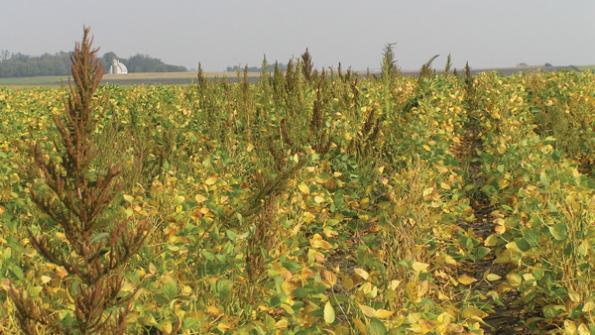April 20, 2012

“It’s a bit challenging to write a single article that encompasses the possible weed management scenarios of a cropping season that currently ranges from emerged corn up to the five-leaf stage, with many fields not yet planted,” said associate professor of weed science Aaron Hager. Here are a few items that might be of interest to weed management practitioners.
While conditions during March and early April were conducive to planting, these same conditions were NOT conducive to good performance of soil-residual herbicides. Many surface-applied herbicides received neither timely precipitation nor mechanical incorporation to move the herbicide into the soil solution.
“Herbicide effectiveness can be significantly reduced when a soil-applied herbicide is sprayed on a dry soil surface with no incorporation, either mechanical or by precipitation, for several days following application,” said Hager. Surface-applied herbicides generally require one-half to one inch of precipitation within seven to 10 days after application for optimal incorporation. The time frame and amount of precipitation needed depend on factors such as soil condition, soil moisture content, residue cover, and the chemical properties of the herbicide.
Broadleaf and grass weeds have emerged in some fields where the soil-residual herbicide was applied to the surface with no subsequent precipitation or mechanical incorporation. Growers have asked whether the soil-residual herbicide will control these emerged weeds once the fields receive sufficient precipitation to move it into the soil.
“The simple answer is that there is no simple answer,” said Hager. Sometimes the herbicide “reaches back” after precipitation to control small emerged weeds.
“For example, we have observed emerged velvetleaf up to about one inch tall turn white following precipitation in research plots treated with isoxaflutole,” he said. However, in other instances, the emerged weeds survive the recently “activated” soil-residual herbicide.
For example, annual grass weeds that have emerged in fields treated with soil-applied chloroacetamide herbicides will not be controlled by that herbicide; a post-emergence herbicide is needed. “Take steps to immediately control weeds that are taller than one inch rather than waiting several additional days after precipitation to see whether the soil-applied herbicide will control them,” Hager advised. Even though the soil-applied herbicide might not control emerged weeds following the next precipitation event, it could still provide residual weed control once the soil receives sufficient precipitation.
“Control emerged summer annual weeds in fields not yet planted prior to planting,” said Hager, particularly in fields containing emerged waterhemp that will be planted to soybean. If the field will be planted with a non-GMO or glyphosate-resistant soybean variety and the emerged waterhemp is resistant to glyphosate, PPO, and ALS inhibitors, there are no herbicides that can control the waterhemp after the soybean emerges.
Waterhemp began to emerge at Urbana during the second week of March, and there have been reports of emerged waterhemp as tall as three to four inches across areas of central Illinois. Established weeds can be quite competitive with the emerging crop plants.
Horseweed (marestail) is growing rapidly in no-till fields that have not yet been treated with a burndown herbicide. “Select the appropriate herbicide or herbicide combination and application rate to ensure good control of these plants,” Hager said.
“If you suspect glyphosate-resistant horseweed, consider adjusting your burndown herbicide program before making an application to increase the likelihood of achieving complete control before planting,” he added. Whether or not a horseweed population is resistant to glyphosate, it is advisable to control horseweed before the plants are more than four to six inches high.
You May Also Like




